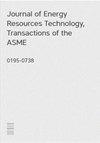Investigation on the effects of nanorefrigerants in a combined cycle of ejector refrigeration cycle and Kalina cycle
IF 2.4
3区 工程技术
Q3 ENERGY & FUELS
Journal of Energy Resources Technology-transactions of The Asme
Pub Date : 2023-10-27
DOI:10.1115/1.4063920
引用次数: 0
Abstract
The main objective of this study is to carry out the thermodynamic analysis of a new power/ refrigeration combined cycle which consists of an ejector refrigeration cycle (ERC) and a Kalina cycle. In ERC, nanorefrigerants are used as the working fluid. Used nanorefrigerants are homogenous mixtures of different base refrigerants (R134a, R152a, R290) and nanoparticles (TiO2 and Al2O3) with 0-5 wt.% nanoparticle concentration. The effects of variation in system operational parameters (nanoparticle mass fraction, evaporator pressure, condenser pressure and superheating degree of motive flow) on energy efficiency and exergy efficiency of the combined cycle are reported. Additionally, net power production, refrigeration capacity, heat input to the combined cycle and their exergy contents are given for the case of TiO2/R290 nanorefrigerant use in ERC. This study is the first ERC analysis in which the effect of R152a and R290 base refrigerants and TiO2 nanoparticle use on ERC performance is investigated. The results show that as the nanoparticle concentration and evaporator pressure increase, the energy and exergy efficiencies also increase. On the other hand, with an increase in condenser pressure and the superheating degree of the motive flow, a decrease in energy and exergy efficiencies is observed. Under all the considered operational conditions of the combined cycle, the highest efficiency results are obtained for R290 and the lowest for R134a base refrigerants.纳米制冷剂在喷射式制冷循环和Kalina循环联合循环中的作用研究
摘要本研究的主要目的是对由喷射器制冷循环(ERC)和Kalina循环组成的新型动力/制冷联合循环进行热力学分析。在ERC中,纳米制冷剂被用作工作流体。使用的纳米制冷剂是由不同的基础制冷剂(R134a, R152a, R290)和纳米颗粒(TiO2和Al2O3)组成的均匀混合物,纳米颗粒浓度为0-5 wt.%。研究了系统运行参数(纳米颗粒质量分数、蒸发器压力、冷凝器压力和动力流过热程度)的变化对联合循环能效比和火用效率的影响。给出了TiO2/R290纳米制冷剂在ERC中使用的净发电量、制冷量、联合循环的热输入量及其火用量。本研究首次研究了R152a和R290基制冷剂以及TiO2纳米颗粒的使用对ERC性能的影响。结果表明,随着纳米颗粒浓度和蒸发器压力的增加,能量效率和火用效率也随之提高。另一方面,随着冷凝器压力和动力流过热程度的增加,能量和火用效率下降。在联合循环的所有工况下,R290的效率最高,R134a的效率最低。
本文章由计算机程序翻译,如有差异,请以英文原文为准。
求助全文
约1分钟内获得全文
求助全文
来源期刊
CiteScore
6.40
自引率
30.00%
发文量
213
审稿时长
4.5 months
期刊介绍:
Specific areas of importance including, but not limited to: Fundamentals of thermodynamics such as energy, entropy and exergy, laws of thermodynamics; Thermoeconomics; Alternative and renewable energy sources; Internal combustion engines; (Geo) thermal energy storage and conversion systems; Fundamental combustion of fuels; Energy resource recovery from biomass and solid wastes; Carbon capture; Land and offshore wells drilling; Production and reservoir engineering;, Economics of energy resource exploitation

 求助内容:
求助内容: 应助结果提醒方式:
应助结果提醒方式:


